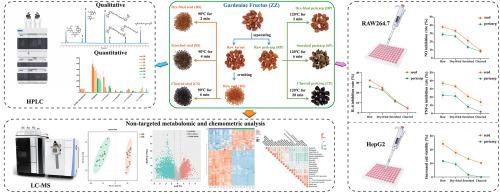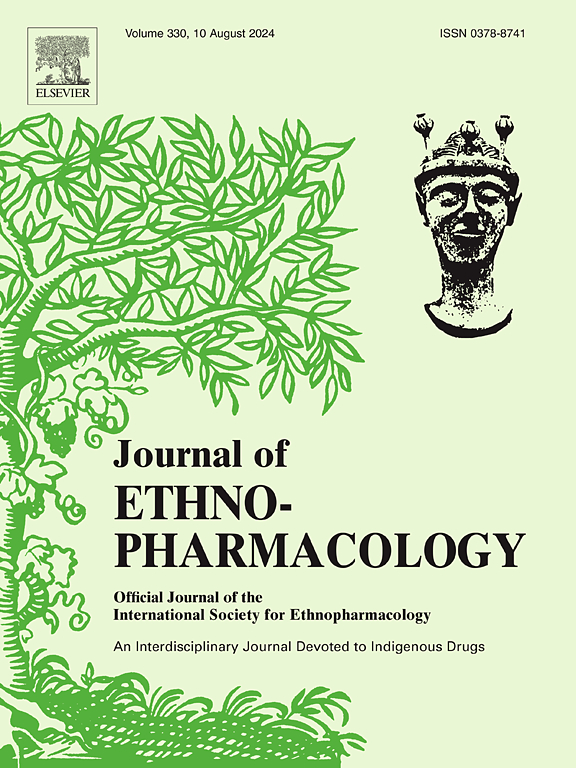Non-targeted metabolomic and chemometric analysis of Gardeniae Fructus (Zhizi): Linking processing to chemical and bioactive changes
IF 5.4
2区 医学
Q1 CHEMISTRY, MEDICINAL
引用次数: 0
Abstract
Ethnopharmacological relevance
Gardeniae Fructus (Zhizi, ZZ), the fruit of Gardenia jasminoides Ellis, exhibits anti-inflammatory and hepatoprotective effects, etc. Processing alters its properties, enhances therapeutic effects, and reduces toxicity. Furthermore, The chemical composition of ZZ seed and pericarp is significantly different. Studying the alterations in chemical components of the seed and pericarp under various processing conditions and the resulting variances in biological activities is highly valuable.
Aim of the study: This study aimed to investigate the changes in the chemical composition and biological activity of ZZ during processing.
Materials and methods
This study employed high-performance liquid chromatography-diode array detection (HPLC-DAD) and liquid chromatography coupled to electrostatic orbitrap high-resolution mass spectrometry (LC-Orbitrap-MS), along with chemometric analysis and non-targeted metabolomics, to investigate variances in components of ZZ seed and pericarp and their transformations during processing. Lipopolysaccharide (LPS)-induced RAW 264.7 cells were utilized to evaluate the anti-inflammatory effects of ZZ by measuring nitric oxide (NO) production with the Griess reagent method. Furthermore, the levels of pro-inflammatory cytokines (TNF-α, IL-6) were determined using ELISA technique. Acetaminophen (APAP)-induced HepG2 cells were used to investigate the hepatoprotective of ZZ.
Results
Using non-targeted metabolomics and chemometrics, the study identified 353 differential features between the ZZ raw seed (RS) and the raw pericarp (RP). During processing, 382 and 386 significant features were found in seed and pericarp, respectively. A total of 210 compounds were identified by reference standards, fragmentation pattern, molecular networking, mzCloud, mzVault, in-house database, and a predictive database. Furthermore, bioassay tests showed reduced anti-inflammatory and hepatoprotective effects during processing. Geniposide and trans-crocin I were identified as primary anti-inflammatory and hepatoprotective compounds.
Conclusion
The chemical difference between the pericarp and seed of ZZ is obvious, and the chemical changes during processing have a significant impact on the activities. Proper processing is crucial for maximizing the therapeutic effects of ZZ.

栀子的非靶向代谢组学和化学计量学分析:将加工与化学和生物活性变化联系起来。
民族药理学相关性:栀子果(栀子,ZZ),栀子属植物的果实,具有抗炎、保肝等作用。加工可以改变其特性,提高治疗效果,降低毒性。籽粒和果皮的化学成分也存在显著差异。研究不同加工条件下种子和果皮化学成分的变化以及由此产生的生物活性差异具有重要的研究价值。研究目的:本研究旨在研究ZZ在加工过程中化学成分和生物活性的变化。材料与方法:本研究采用高效液相色谱-二极管阵列检测(HPLC-DAD)和液相色谱-静电轨道阱高分辨率质谱(LC-Orbitrap-MS),结合化学计量学分析和非靶向代谢组学,研究了ZZ籽和果皮在加工过程中成分的差异及其转化。利用脂多糖(LPS)诱导的RAW 264.7细胞,采用Griess试剂法测定一氧化氮(NO)的产生,评价ZZ的抗炎作用。此外,采用ELISA技术检测促炎因子(TNF-α、IL-6)水平。用对乙酰氨基酚(APAP)诱导的HepG2细胞研究了ZZ的肝保护作用。结果:采用非靶向代谢组学和化学计量学方法,鉴定了ZZ生籽(RS)与生果皮(RP)之间的353个差异特征。在加工过程中,在种子和果皮中分别发现了382和386个显著特征。通过参考标准、碎片化模式、分子网络、mzCloud、mzVault、内部数据库和预测数据库共鉴定出210个化合物。此外,生物测定试验显示加工过程中抗炎和保护肝脏的作用降低。京尼平苷和反式藏红花素I被鉴定为主要的抗炎和保肝化合物。结论:紫苏果皮与种子的化学成分差异明显,加工过程中的化学变化对其活性有显著影响。适当的处理对于最大化ZZ的治疗效果至关重要。
本文章由计算机程序翻译,如有差异,请以英文原文为准。
求助全文
约1分钟内获得全文
求助全文
来源期刊

Journal of ethnopharmacology
医学-全科医学与补充医学
CiteScore
10.30
自引率
5.60%
发文量
967
审稿时长
77 days
期刊介绍:
The Journal of Ethnopharmacology is dedicated to the exchange of information and understandings about people''s use of plants, fungi, animals, microorganisms and minerals and their biological and pharmacological effects based on the principles established through international conventions. Early people confronted with illness and disease, discovered a wealth of useful therapeutic agents in the plant and animal kingdoms. The empirical knowledge of these medicinal substances and their toxic potential was passed on by oral tradition and sometimes recorded in herbals and other texts on materia medica. Many valuable drugs of today (e.g., atropine, ephedrine, tubocurarine, digoxin, reserpine) came into use through the study of indigenous remedies. Chemists continue to use plant-derived drugs (e.g., morphine, taxol, physostigmine, quinidine, emetine) as prototypes in their attempts to develop more effective and less toxic medicinals.
 求助内容:
求助内容: 应助结果提醒方式:
应助结果提醒方式:


